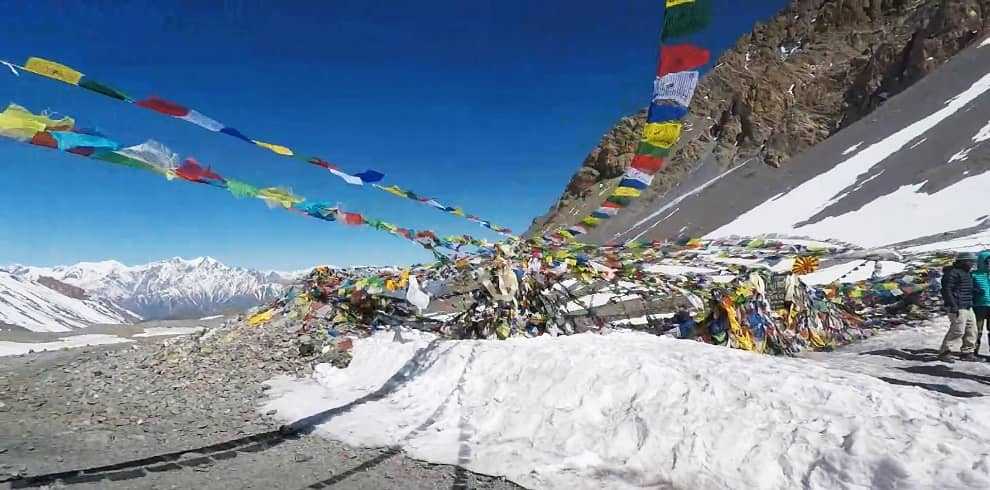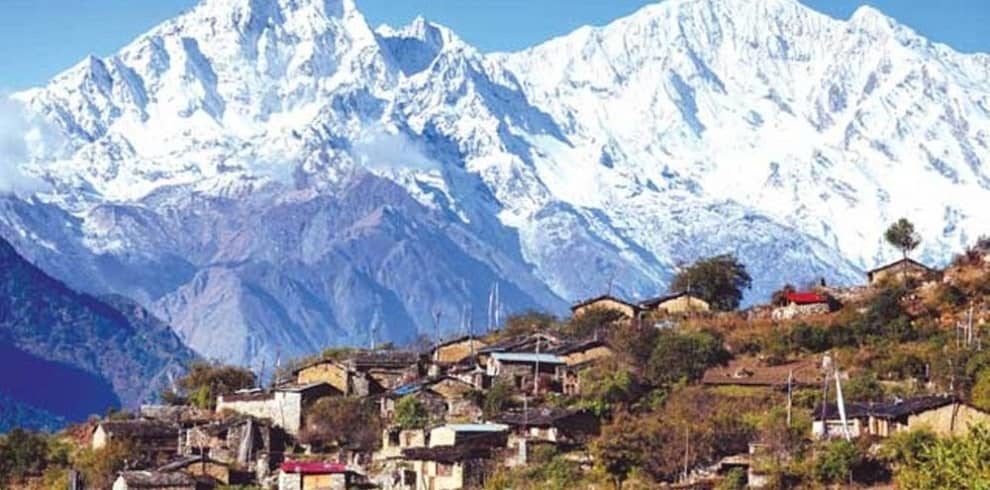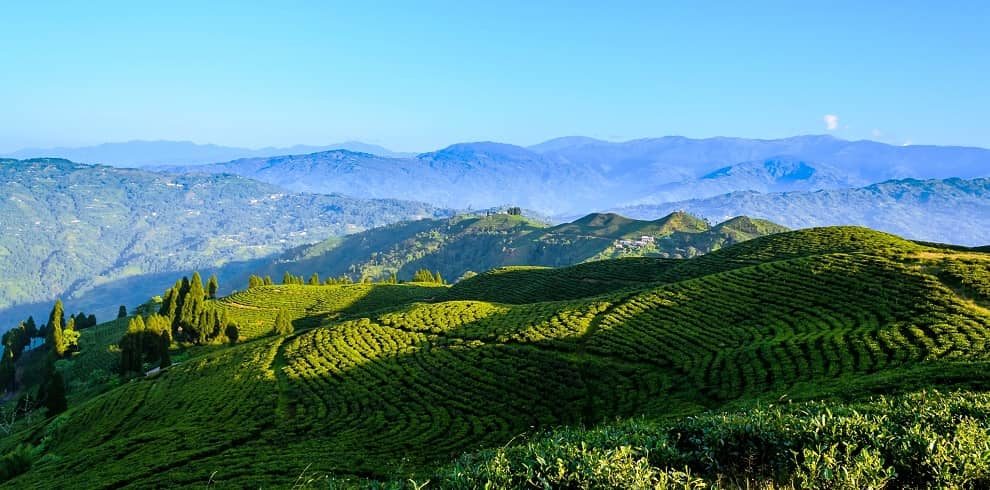Introduction To Annapurna Circuit Short Trek In Nepal
The Annapurna Circuit Trek is a fulfilling trek where you will be able to enjoy the panoramic sceneries of the Himalayas including –Mt. Dhaulagiri (8167m), Mt. Annapurna I (8091m), Mt. Manaslu (8,163m), Mt. Annapurna III (7,555m), Mt. Annapurna south (7,219m), Mt. Annapurna IV (7,525m), Mt. Nilgiri (7,041m), Mt. Machhapuchhare (6,998m), Mt. Hiun (7,134m).
You’ll have the chance to see Tibetan-style Buddhist villages as well as Manang settlements and learn about their culture. You’ll pass through rice paddy fields, subtropical woodlands, rural farming, and glacier zones on your way around the circuit.
Along with blue sheep, there’s a potential of witnessing a snow leopard at Yak Kharka. We’ll pass via Jomsom’s bustling market center, a welcome contrast from the gorgeous farms and rural towns, and halt at Tatopani to rest in the famous hot springs after a day of trekking.
We begin our journey in Kathmandu by boarding a local bus to Besisahar, where we will register our permits. We catch a local bus the next day for a picturesque drive to Chame, our destination for the day. We stop in Dharapani along the way to finish the paper (Trip Permits) formalities for the Annapurna area trek.
We start our trip from Chame to Pisang the next day, and our route takes us through a beautiful forest. We’ll stop to see Paungda Danda Rock along the route. We will rest for the day once we arrive in Pisang.
The next morning, we leave Pisang and travel to Manang, taking in views of Annapurna II, III, IV, and Gangapurna from the north face. We spend the night in Manang and then travel to Ledar the next day.
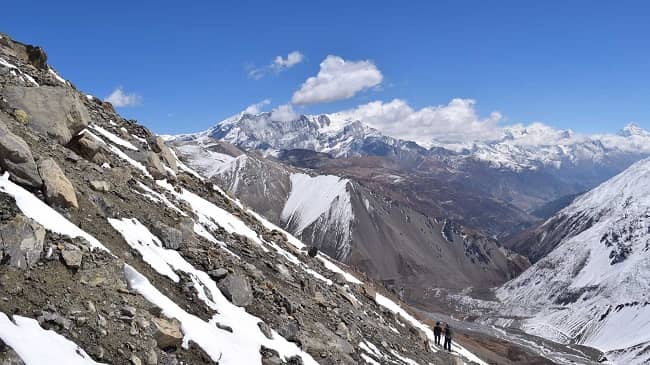
Our journey takes us from Ledar to Thorong Phedi on the sixth day and we arrive in Ledar on the fifth day. The seventh day is a thrilling one. We begin in Thorong Phedi, travel via the Thorong La High Pass, and descend to Muktinath, a sacred Hindu and Buddhist pilgrimage site.
We leave Muktinath the next morning after spending the night there and travel to Jomsom, then to Tatopani for the night. We travel from Tatopani to Pokhara via Beni Bazaar the next day, and then from Pokhara to Kathmandu.
As an alternative to our 14-day Annapurna Circuit Trek, which circumnavigates the entire Annapurna region, we have devised the Annapurna Circuit Short Trek (10 days) for passionate trekkers who can hike 6 to 7 hours per day.
A local bus journey from Kathmandu to Besi Sahar or Bhulbhule is included in this package. A private jeep can be rented for an additional fee. Similarly, you have the option of taking a self-funded (flight cost not included in the package) flight from Pokhara to Kathmandu on your way back. Our clients should also arrive in Kathmandu one day prior to the trip departure date (before 3 p.m.) to participate in the trip briefing. We’ll use the trip briefing to go over all of your gear and equipment, as well as set your journey expectations.
Highlights Of Annapurna Circuit Short Trek In Nepal
- At 5,416 meters, Thorong La Pass is one of the highest passes in the world.
- Yak Kharka has blue sheep.
- Spectacular views of Mt. Annapurna, Thorung Peak, Nilgiri, Chulu West, and Chulu East, Tukuche Peak, Dhaulagiri,
- Lamjung Himal, Annapurna II, and Annapurna IV, Tukuche Peak, Dhaulagiri, Lamjung Himal, Annapurna II, and Annapurna IV
- The Kali Gandaki is the world’s deepest river. Beautiful lakes, glaciers, gorges, and waterfalls, George
- Visit Muktinath, a Hindu and Buddhist pilgrimage site.
- Interact with the residents of the beautiful Manang district.
- The bustling market in Jomsom
- Visit the Barge Monastery, the largest in Manang, and the Tatopani Hot Springs.
Benefits Of Annapurna Circuit Short Trek In Nepal
- Private transportation from and to the airport is provided free of charge.
- At high altitudes, provide a pulse oximeter to check blood oxygen saturation levels. It’s a crucial signal for spotting early indicators of imminent altitude sickness and other health hazards.
- During the walk, surplus luggage can be stored for free at the Discovery World Trekking store Medical Kit.
- If you don’t have your own, sleeping bags and down jackets can be rented.
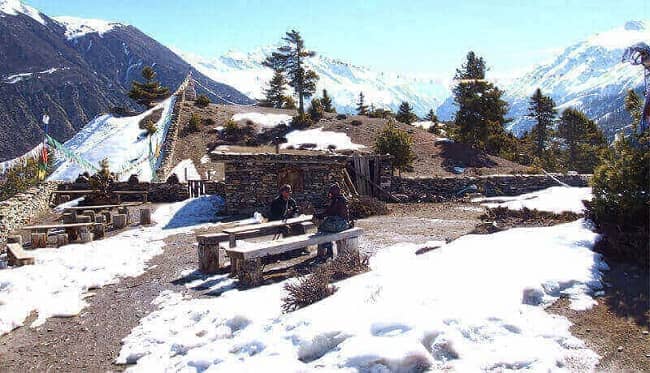
Gears for Annapurna Circuit Trek in Nepal
Annapurna Circuit Equipment Treks vary depending on the season, and you may need to make adaptations as a result. However, we’ve put up a list for your convenience. Please just bring what you absolutely need.
Head
- Scarf or hat for the sun
- Winter hat, insulating hat, or a hat with a wide brim
- Extra batteries for the headlight
Face
- Sunscreen
- Sunglasses that block UV rays
- Wipes for the face and body
Hands
-
Lightweight gloves
-
Heavyweight winter gloves
Body
- Shirts for hiking
- Shirt with a long sleeve made of synthetic fiber.
- Rain jacket with hood
- Jacket made of fleece
- Cotton pants that are light and airy.
- T-shirt (bring lightweight wool)
- Underwear made of polypropylene
- Jacket with down feathers (available for rent in Kathmandu)
- Sweater
- Jacket and pants that are waterproof
Footwear
- Boots for Hiking
- Socks made of thick wool (Take an extra pair of thick light socks)
Essential gear
- A daypack or a backpack (Size depends on whether you take a porter or not)
- Bottle with a heating element
- Purification of water
- Pole for hiking
- Bag for sleeping (-15 degree bag is best for high altitude trekking)
Toiletries
- a drying towel of medium size
- Toothbrush
- Toothpaste
- Deodorant/floss/toilet paper
- Biodegradable soap in a bar
- a pair of nail clippers
- Mirror, little
Personal accessories
-
Money
-
Watch
-
Cell phone
-
Camera
Extra items
- Kit for first aid
- Extra passport pictures and passport photocopies
- Pencil and notebook
- Binoculars
Annapurna Circuit Trip Info: Cost, Trip Grade & Best Time
Safety precautions for the Annapurna Circuit Trek
Despite the fact that the Annapurna Circuit Journey takes place at high altitudes, it is a fully safe trek. We take a number of safeguards to assure your safety so you can relax and enjoy your experience. For the sake of safety –
- Our guides have received extensive wilderness first-aid training, and we utilize high-quality masks, gloves, and hand sanitizers on a daily basis.
- For motivation and encouragement, we brighten your attitude.
- We review meals and accommodations for hygiene.
- Our trip leaders and guides have years of trekking experience.
Annapurna Circuit Trek Itinerary beginning
To participate in the trip briefing, you must arrive in Kathmandu at least one day prior to the trek departure date (before 3 p.m.). From Tribhuvan International Airport, a representative will greet you and transport you to your hotel.
Your trip guide will pick you up from your accommodation on the second day and drive you to the bus station, where you will board a bus to Besisahar.
The package includes local transportation (from Kathmandu to Besisahar, Besisahar to Chame, and Muktinath (via Jomsom) to Tatopani). A private jeep can be rented for an additional fee.
Complimentary airport transfer service on your Annapurna Circuit Trek Tour
On your arrival, we will pick you up from the airport and drop you off at your hotel in a private vehicle, and vice versa on your departure. Our agent will be holding a booklet with your name on it at the Tribhuvan International Airport. As a welcoming gesture, they will either give you a Khada or Marigold garland and then drive you to your accommodation. To take use of this free service, please provide your flight information.
Accommodation in the Annapurna Circuit Trekking Route
The Annapurna Circuit Journey is a 10-day trek that includes lodge-to-lodge stays throughout the hiking districts and one night in Pokhara at the best available hotel. At all times, we choose the best available accommodations.
At Besisahar, Chame, Pisang, Muktinath, and Tatopani, you will spend five nights in twin sharing rooms with a private connected bathroom. At Manang, Ledar, and Thorong High Camps, you’ll spend three nights in twin-sharing standard accommodations.
We’ll spend one night in a Pokhara hotel room with an attached bathroom, TV, 24-hour hot water, electricity, and laundry facilities.
Wherever possible, solo visitors will be accommodated in a single private room with an attached bathroom, as well as single private standard rooms in other locations.
It is possible that two nights in Kathmandu are necessary before and after the walk, however, this is not included in the program. Kathmandu offers a diverse selection of hotels to fit your preferences and budget.
Food on Annapurna Circuit Trek
Because our adventure takes us to high altitudes near the world’s tallest peaks, you’ll need plenty of carbs, protein, and other nutrients. We’ll provide you with nutritious meals, but you won’t have as many options as you would in a big city.
During the walk, we will offer 10 breakfasts, 9 lunches, and 8 evenings. Ten breakfasts – Oatmeal, Corn Flakes, French toast with Jam, Butter, Cheese, Honey Tibetan bread or Chapati, Local Tsampa porridge, Eggs, Pancakes, Muesli Breads, Fruits, and Vegetables are some of the most popular menu items. Drinks that are heated (varieties of teas and coffees, hot chocolates, etc.)
Nine meals, including Dhal, Bhat, and Tarkari, Tibetan Bread, Various Soups, Sherpa Stew, Steaks, Sandwiches, Momo (dumplings), Macaroni dishes, Tenduk Spaghetti Noodles, Thukpa, Pasta, Vegetable curry, Potatoes, Vegetables, Salad Pizza (Tomato, Mushroom, Mixed), Snacks (Papad, Prawn), Dessert
Dhal, Bhat, and Tarkari, Tibetan Bread, Various Soups, Sherpa Stew, Steaks, Sandwiches, Momo (dumplings), Macaroni, Tenduk Spaghetti, Noodles Thukpa, Pasta, Vegetable curry, Potatoes items, Vegetable and salad Pizza (Tomato, Mushroom, Mixed), Snacks (Papad, Prawn), Korean Raman, Desserts (Rice
Traditional, Asian, and Western foods are available on menus in various regions. However, as we progress up the menu list, it will become shorter.
At high elevations, we strongly advise you to consume fresh vegetables and liquids such as green tea, lemon tea, hot lemon, ginger tea, and garlic soup (must).
Though there are many of non-vegetarian options in trekking areas, we do not advocate them because the meat may not be hygienic. We also recommend avoiding dairy products, as well as alcoholic beverages, caffeinated beverages, and hot chocolates.
Note that the company will not provide lunch or dinner in Pokhara.
All personal costs (alcoholic drinks, hot (tea, coffee, etc.), and cold drinks at tea houses/ Lodges or cafes are excluded from the program, save for standard meals (breakfast, lunch, and dinner with seasonal fruits).
Best Season for Annapurna Circuit Trek
When planning an Annapurna Circuit Trek Tour, the weather is the most crucial element to consider. Though the Annapurna Circuit Trek is possible all year, it is easier in certain seasons.
Trekking in the spring and autumn, when the skies are clear, is easier and allows you to enjoy spectacular views of the landscape.
Due to severe snowfall and harsh temperatures, trekking becomes more difficult in the winter, but it also attracts many adventurous hikers. Similarly, during the Monsoon, the pathways may become slick and the vistas may be obscured by clouds.
The temperature in the mountains varies depending on the season and height. Here’s a look at the weather in Annapurna Circuit Treks’ high elevations.
March-May (spring)
Mountaineers and travelers go to Annapurna Circuit trek in great numbers during the spring season (March-May). The weather is pleasant, the rainfall is light, and the trekking conditions are ideal during this season.
The average daily temperature in the high elevations ranges from 5 to 0 degrees Celsius. Lower portions of the walk are warmer, making it enjoyable for all trekkers during this season.
After March, the hiking season begins. At heights of up to 3,000 meters, the trek path in the Himalayas will be lined with red, pink, and white rhododendron blooms by April.
From mid-March until mid-May, the temperature begins to rise. The weather is pleasant, the skies are clear, and the mountains are seen in all their glory.
June to August (summer)
Nepal’s summer lasts from June to August. The temperatures are undoubtedly hot, but the Monsoon season, which coincides with summer, makes the trip pathways wet and slick.
The monsoon season usually starts at the end of June and lasts until the second week of August.
The temperature at high elevations typically ranges from 10°C to 23°C during the day and drops to 5°C to 10°C at night. The mornings are mostly clear, with clouds forming in the afternoon but dissipating at night.
During this season, a variety of plants bloom, the valleys turn green, and you can see views that are radically different from those seen during other seasons.
September to November (autumn)
The Annapurna Circuit hikes are popular in the autumn (September, October, and November), much as they are in the spring. Autumn is an ideal season for trekking in Annapurna because of the moderate temperatures, light winds, and low precipitation.
The sun is shining brightly, the skies are clear, the temperature is ideal for hiking, and you have a spectacular view of the mountains.
At night, the sky is filled with stunning starry heavens. By early September, the monsoon will have passed, and daytime temperatures at high altitudes can reach up to 20°C, with nights being slightly cooler at around 5°C.
The greens that developed during the Monsoon fade to a golden/amber color, creating a stunning contrast with the crystal blue skies. Terraced farms with maturing grains will be visible.
The lowlands are lush and the environment is clean. Dashain and Tihar, Nepal’s two most important festivals, fall at this time. All trekkers will be happier as a result of this.
December to February (winter)
Treks in the Annapurna circuit during the winter months (December to February) are also popular. The Annapurna circuit hike can be frigid in some spots, but many trekkers like it. The Annapurna Circuit Trek’s high elevations can have temperatures as low as -10 °C. However, with adequate sunlight, midday is pleasant and rather warm.
From late December to early February, it is the coldest. The weather steadily warms in late February.
The skies are frequently clear, and the mountains are at their best, despite the cold. It snows at higher elevations, and the paths are less crowded. Although it is not the finest hiking season for beginners, experienced trekkers would have little difficulty.
At high altitudes, the weather is unstable and changes rapidly.
Trip Grade: Fitness level, Medical, and Health
The Annapurna Circuit Trek is a tough short trek that is an alternative to the 14-day Annapurna Circuit trek.
We will trek for 6 to 8 hours per day in the lower lands below 3,500m, from Chame (2,710m) to Manang (3,540m), and 3 to 4 hours per day in the high highlands above 3500m, from Manang to High Camp (4,900m), because trekking at high altitude is physically hard.
Previous hiking experience would be beneficial, but no technical knowledge is required.
This Annapurna Circuit Trek can be completed by hikers who can hike for 6-8 hours per day at a reasonable pace. The trek itineraries include long climbs, sharp descents, and steep forward tracks via rocky slopes and woodlands.
Exercising and running on a daily basis for a few weeks prior to the trip is a good idea because it improves stamina. Trekkers must be in good health, have a respectable level of physical fitness, and have a positive attitude, self-confidence, and desire to participate in the Annapurna Circuit Trek.
Participants with pre-existing medical concerns including heart, lung, or blood disorders should let us know before signing up for the walk. You should also listen to your doctor’s advice.
Annapurna Circuit Group Trek | Private Single Trek | Private Family Trek
We organize both group and private treks. Group discounts are available dependent on the size of your group. The larger your group, the greater the savings. Please see our price list for further information. Simply click the – we offer group discounts – link on the right.
We can accommodate any size group. Each group will have a guide, and we will assign a porter to every two trekkers. We will provide an assistant guide for groups of 12 or more.
A typical day on Annapurna Circuit Trek
You’ll be trekking, climbing, admiring the landscape, taking photos, and touring the surrounding villages every day. Our skilled Sherpa guide will share information and historical facts about the regions you will be hiking with you during the expedition/trek.
The majority of your luggage will be carried by porters. However, you may need to bring a small backpack with you to protect your belongings.
The day begins with a nice cup of tea or coffee in the morning. We head off on the day’s walk after breakfast, between 7 and 8 a.m., depending on the length and nature of the trek. We’ll have lunch about midday on the way to the next destination after trekking for three to four hours. We’ll take an hour off before continuing our journey.
The afternoon stroll is usually shorter, lasting between two and three hours. We munch on the extra dietary food and explore the town/village where we will be spending the night after we get at our overnight lodge/tea house/tent.
Around 6.30 p.m., we serve dinner. We’ll spend some valuable time in nice discussions before heading to bed. Your excursion leader/guide will give you an overview of the next day’s activities.
After the briefing, you can play monopoly, play cards, or watch mountaineering films onboard. The majority of our visitors want to learn common Nepali words as well. If you enjoy reading, you can bring one or two novels with you.
Communication during the trek
For an additional fee, you can use internet access at the lodges while on the Annapurna Circuit Trek. However, after we reach high altitudes, we will use phones to communicate. The Office will communicate with all trek teams via the team guide at least once a day.
You may receive signals, but they may not be powerful enough, depending on the network service you choose. In Kathmandu, you can purchase a local SIM card if desired.
In most lodges/lodges, Wi-Fi is available during the walk for an additional fee.
Electricity for battery recharge, water for trekking
For an additional fee, electricity for the camera and mobile battery recharge is available throughout the lodges where we will be staying throughout The Annapurna Circuit Short Trek.
Similarly, local lodges and en-route shops provide packed mineral water, or you can fill your water bottle with hot water. If you require it, we may also give water purification pills.
You should avoid drinking water from rivers, taps, and wells in such areas since it may be contaminated.
Extra personal cost during the Annapurna Circuit Trek
In Kathmandu, you must make arrangements for meals and lodging. Except for lunch and dinner in Pokhara, all meals, transfers, and lodgings for the Annapurna circuit trekking are included.
Trekkers will need personal spending money to cover the price of lodging in Kathmandu, visa fees, travel insurance policy purchase, beverages, snacks, souvenirs, tips to trekking crew members, and other personal expenses.
We recommend that you carry cash (major currencies) to Kathmandu and exchange it there. You can withdraw money from an ATM using your debit or credit card.
Insurance requirements for Annapurna Circuit Trek
The Annapurna Circuit Trek requires insurance. Altitude illness and other unforeseeable circumstances, such as climate change, are a possibility.
Before beginning the trek, all trekkers must produce a copy of their complete travel insurance policy certificate to us. Medical and emergency repatriation must be covered, as well as helicopter rescue and evacuation costs at high altitudes.
We can make recommendations for insurance companies based on our clients’ experiences, but we do not sell policies.
Members of the trekking party are kindly asked to email their comprehensive insurance information once they have made a reservation for the hike. In the event of an emergency, your insurance policy and the informational documents you supplied us will be used to conduct a swift rescue operation or reimburse your medical bills.
Do not solely depend on the information supplied on an insurance company’s website. Call them and double-check that they cover helicopter rescue and evacuation charges up to 6000 meters, as well as all medical costs.
Visa on Arrival | Nepal Tourist visa
Except for Indian nationals, all foreigners must have a valid visa to enter Nepal. An on-arrival visa is available at the Tribhuvan International Airport and Nepali borders with India and Tibet. Visit www.immigration.gov.np for more information on visas.
You’ll need a passport that’s at least six months old, one passport-size photo, and a visa cost to apply for the visa. The current visa charge for a 30-day stay is USD 50, which must be paid in cash.
Citizens of China and members of the South Asian Association for Regional Cooperation (SAARC) (Bangladesh, Bhutan, India, Maldives, Pakistan, and Sri Lanka) are exempt from visa fees.
On-arrival visas are not available for citizens of Nigeria, Ghana, Zimbabwe, Swaziland, Cameroon, Somalia, Liberia, Ethiopia, Iraq, Palestine, and Afghanistan. If you are a citizen of one of these countries, you should contact the Nepali embassy in your country.
Money Exchange | USD to NPR
Nepali Rupees (NPR/Rs) are the local currency.
(1 USD = (around) Rs.120 NPR).
n Kathmandu and across Thamel, we may exchange most international currencies at local banks and reputable money exchanges. The hotel can also exchange small sums of cash.
The current currency rate is clearly indicated. The Nepalese government has outlawed the import, export, and usage of 500 and 1000 rupee notes. You should not carry these notes with you when you arrive in Nepal, as they will be confiscated and you may be punished.
Despite the security of traveler’s cheques, we choose cash conversion to avoid the difficulties of a long process and a hefty commission rate at the banks. You can get cash (only in Nepalese Rupees) at one of the many ATMs in Kathmandu and Thamel. There are a number of ATMs that are open 24 hours a day. If you use your foreign card, the maximum withdrawal amount is 35,000 Rupees with a 500 Rupee processing fee.
If you utilize a bank or financial institution’s money exchange service, you will be charged a service fee of around 4% or more, depending on the bank.
Because there are no banks or money exchange services along the trail, you should exchange your money in Kathmandu alone, depending on how much personal expenditure you anticipate, as individuals in the Himalayan region only accept Nepalese currency.
Foreign currency notes that are old, damaged, or faded will not be accepted by the majority of Asia’s established banks. Please make sure you have fresh, clean notes.
How much luggage can I take during the Annapurna Circuit Trek?
One porter is assigned to every two trekkers, and the porter’s maximum combined burden is 18 kilograms. As a result, each trekker’s luggage weight limit is 9 kilograms. We also anticipate you carrying a modest backpack containing your belongings. Please only bring the bare minimum with you. Your excess luggage can be left at your hotel or in our office store.
During our tour briefing, you will also double-check your luggage and equipment.
Responsible Travel in Annapurna Circuit Trek Tour
As an eco-tour company, we are conscious of the environmental effects of our actions and strive to conserve the environment as much as possible.
Please be considerate of the environment and refrain from littering. We collaborate with the Kathmandu Environmental Education Project (KEEP) to plan environmentally conscious itineraries that benefit both travelers and communities.
Our Hiking Team
Our skilled and experienced guides/Sherpas will accompany you on the Annapurna Circuit Trekking. A porter will be assigned to every two trekkers. A porter’s combined weight limit is 18 kg.
Our crew members’ physical endurance at high elevations is extraordinary because they are locals from remote high Himalayan villages.
We value each and every one of our employees. We pay them handsomely and cover all of their expenses, including insurance, clothing, food, and shelter. When they become unwell or injured, they receive medical attention. Only a happy individual, can keep others happy. As a result, we make every effort to keep our employees satisfied.
Our team consists of the following individuals:
- Authorized Trekking Guide Training Certificate
- Intensive Wilderness First Aid Training
- Fluency in English and another major language
- Conservation and Biodiversity Training
- Experience with rock climbing
Tipping in Nepal
Tipping is accepted and respected in Nepali society, and it is a form of expressing thanks. Tipping is at the discretion of hikers and is based on service quality. We recommend tipping at the end of the hike and as a group.
100 % Secure Payment | MasterCard | Visa | American Express| Other Methods
We are a government-approved and bonded trek and tour company in Nepal. We are also members of the Nepal Mountaineering Association (NMA) and the Trekking Agency Association of Nepal (TAAN). As a result, you may book your trek/expedition with complete trust.
As a deposit, we require 10% of the total trip cost. Within a week of booking, please send your documentation, including a copy of your passport, passport-size pictures, travel insurance policy, and arrival and departure flight information.
You can make a 10% deposit via bank transfer, western union, or online payment on our website, and the full balance when you arrive in Nepal. Cash, bank transfer, and credit cards are all acceptable methods of payment. In addition, you will receive payment choices in your email.
Last-minute booking on Annapurna Circuit Group Trek | Private Trek
We offer last-minute bookings for individuals who are unable to book Annapurna Circuit Trek in advance. You must pay 100% of the trek cost 24 hours before the trip begins to take advantage of this service.
We make every effort to run last-minute treks/trips on your scheduled date. However, there is a slight potential for a journey delay owing to factors beyond our control, such as terrible weather or a lack of housing.
Trip Extensions
If you have extra days after the trip, you can embark on a sightseeing tour in Kathmandu or the surrounding districts. In Chitwan, you can also embark on a jungle safari, paragliding, rafting, canyoning, or other treks.
Feedback
We offer a farewell meal at the end of the trek, and we will also award you with a trek completion certificate after dinner (hard copy). It’s also a great opportunity to tell us about your experience and provide us feedback.
USEFUL INFO ABOUT ANNAPURNA CIRCUIT SHORT TREK
Please note that the 10-Day Annapurna Circuit Trek has set departure dates from Kathmandu and Pokhara, however, we may customize a tour to meet your specific needs and timetable.
Please review your trek’s scheduled departure date, and if the scheduled departure date does not work for you, please contact us. We can reschedule the excursion at your leisure.
The above-mentioned schedule may be altered due to unforeseen circumstances beyond our control. However, we make every effort to comply with the schedule.
We look forward to accompanying you on a journey across the Annapurna region, which is widely regarded as the best long trek in the world.
You may also visit Bardiya National Park Tour-Cost, Distance, Itinerary, In Nepal – 4 Days
Overview Of Annapurna Circuit Short Trek
- The Annapurna Circuit Trek is a lovely combination of trek and adventure in the Annapurna region, where we can view stunning deep gorges, desolate high mountain passes, and gigantic snow-capped mountain ranges, as well as calming hot springs, Buddhist and Hindu temples, and charming farming communities.
- Fishtail, Hiunchuli, Annapurna Massif, Dhaulagiri, Tilicho, Pisang, Pungda Danda, and countless other peaks can all be seen from the Annapurna Base Camp.
- You’ll stop by the famous Poon Hill viewpoint and rest in the natural hot water pool at Jhinu Danda along the route.
